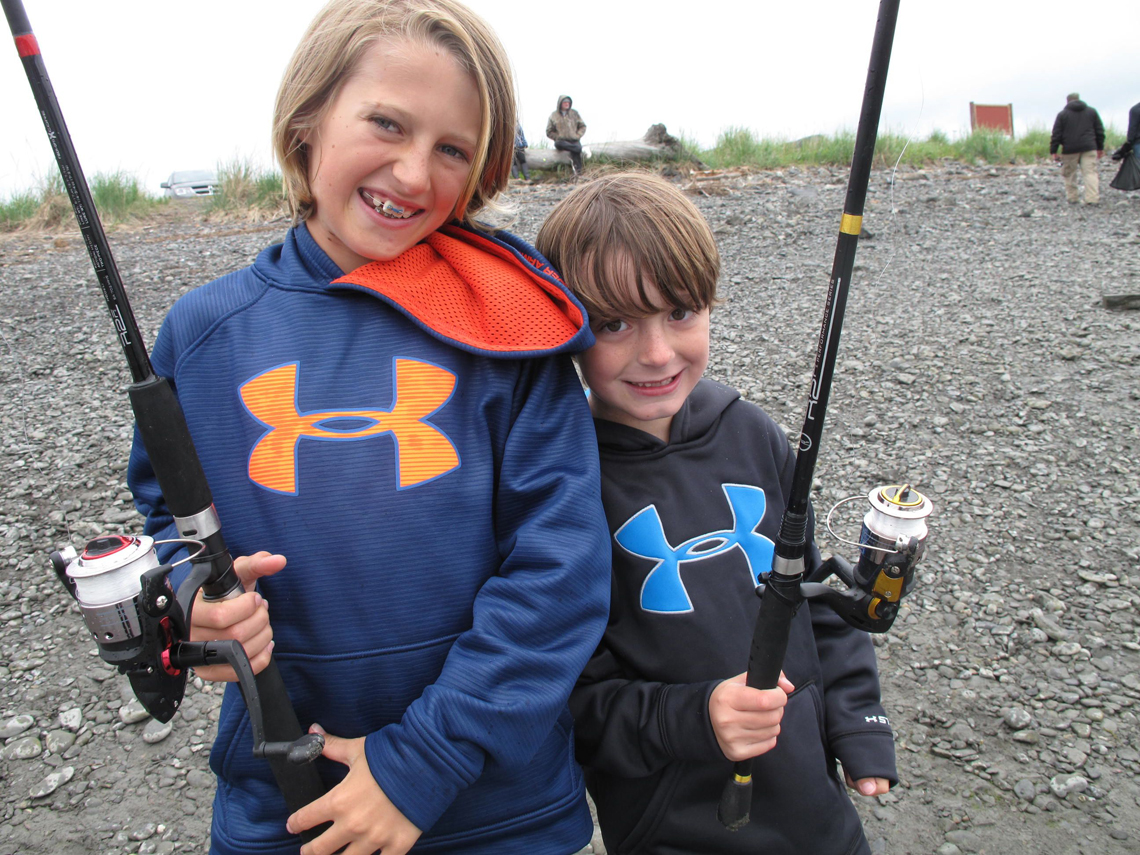Tom Schroeder’s got time on his hands. So much time he’s booked about 150 hours so far this season at the Nick Dudiak Fishing Lagoon, otherwise known as the Fishing Hole.
Schroeder has fished the Hole since the first salmon returned after the original smolt were stocked here in 1984. When the fish are in, chances are you can find him sitting on a white plastic lawn chair with a black cushion on top along the Hole’s rocky edge.
It’s not quite three in the afternoon on a Monday in early June. Overcast sky and a cold, damp wind. Schroeder’s got on his heavy-duty Carhartt winter coat, jeans and sturdy rubber boots. He’s posted on the south side of the Hole, rod tip to the sky, a pile of line at his feet. Fishing like this builds up no body heat.
“We had a pretty fair bite at about 8:30 this morning,” he says.
Schroeder arrived at a quarter past five. Retired from a 25-year career in fisheries with Alaska Department of Fish and Game, he knew Nick Dudiak, the state biologist who envisioned the Hole as a fishery accessible to everyone that would also be a financial boon to the community. Each year, king and silver salmon — stocked here as juveniles — return to the Hole looking for a non-existent stream in which to spawn.
Schroeder won’t say how many kings he’s landed so far this season. “Let’s just say I’m on my second proxy.” Regulations allow for an individual to fish the quota of other persons who aren’t able to fish for themselves.
The only set-up Schroeder uses is a double-hooked mooching rig with a piece of herring and a piece of “secret” bait. He’s got a number nine Fenwick fly rod with a Pflueger reel, probably 45 years old. “I’ve used a fly rod all my life so it feels more comfortable to me,” he said. “It keeps a tight line.”
You get every variation of gear in the Lagoon. Recently, a group of scuba divers were swimming around the Hole with spears.
And a guy with a rubber raft and an outboard puttered into the Hole earlier this season. This is a good way to get a hook in your eye.
“We try to explain it’s a shore-based fishery,” Schroeder said, putting it gently.
He and a handful of regulars are the Hole’s self-appointed vigilantes. He thinks he could pay for two State Troopers’ salaries with the number of tickets he could write.
“My buddies and I have fish and wildlife troopers on speed dial,” he said.
Over the years, Schroeder has observed various ways people illegally snagged fish in the Hole before regulations caught up and prohibited those gear set-ups. Snagging is only allowed at the end of the runs and then only by emergency order. The old method was a practice called straight-lining. These days it involves marshmallows.
According to Jan Jaegar, an 11-year veteran of the Hole, the most important piece of equipment is patience.
“You have to put your time in, but eventually you get one,” she said.
In addition to sheer persistence, she uses a bait caster with Vibrax lure and what she calls “buoy bobs”—bright pink artificial salmon eggs—on a treble hook. She’s got three kings in the freezer so far this year: 20, 16 and 8 pounds.
“You always know when Tom’s here it’s a good time to fish,” Jaegar added.
Schroeder started keeping a daily log of landings in 2008. He can give you a calculation of the total fish taken from the Hole in a day and so far this season: 202 kings and 27 jacks — or year-old kings. At least this is what he’s observed from his white plastic perch, and doesn’t include the channel or outside the Hole.
Another bit of his math: it takes on average 10-15 hours of fishing to catch a king.
This year, the state will dump about 210,000 king and 120,000 silver salmon smolt into the Lagoon.
Just like king salmon runs across the state, king returns in the Hole have been pretty miserable in recent years. State biologists think there are a number of factors at play. One has been poor survival of smolt due to an algal bloom of Chaetoceros, a plankton with silica in its cell walls that cuts the fishes’ gills and can kill them. In the Lagoon, this means that ADFG workers hold smolt in pens for a minimum amount of time before releasing them so the young fish can swim into deeper water to escape the algae.
But there is also poor king salmon survival in Cook Inlet generally and across the state. State biologists might not be ready to blame climate change, but it’s clear to many others that climate-related ocean changes are threatening fish runs all over Alaska.
This year, however, Carol Kerkvliet, ADFG Assistant Area Management biologist, is encouraged. She relies on Schroeder’s numbers to get a sense of how many fish have been harvested in the Hole — and the numbers look good.
Schroeder thinks it’s the best king run in six or seven years.
There could be weeks left of good king fishing on the Spit. Silvers will start coming into the Lagoon in mid-July. If you’re wondering, the official word on snorkeling in the Lagoon is “legal but inadvisable.”
And Schroeder’s secret bait? “Everyone knows it’s mackerel,” he said.
His bobber dives. “Come on! Take it, you sucker!” Then it pops up, and the line goes slack.
Schroeder’s Advice
for Beginner Anglers at The Fishing Hole
• Use a spinning rod with a No. 4 or No. 5 Vibrax lure.
• Cast out and reel in fairly slowly to keep the lure a couple of feet below the surface.
• Kids should be set up with bobbing rigs: a bobber with a treble hook baited with herring about 3 feet behind the bobber.
• Get some space away from other people.
• Enjoy yourself.


